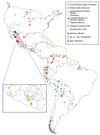A single domestication for maize shown by multilocus microsatellite genotyping
- PMID: 11983901
- PMCID: PMC122905
- DOI: 10.1073/pnas.052125199
A single domestication for maize shown by multilocus microsatellite genotyping
Abstract
There exists extraordinary morphological and genetic diversity among the maize landraces that have been developed by pre-Columbian cultivators. To explain this high level of diversity in maize, several authors have proposed that maize landraces were the products of multiple independent domestications from their wild relative (teosinte). We present phylogenetic analyses based on 264 individual plants, each genotyped at 99 microsatellites, that challenge the multiple-origins hypothesis. Instead, our results indicate that all maize arose from a single domestication in southern Mexico about 9,000 years ago. Our analyses also indicate that the oldest surviving maize types are those of the Mexican highlands with maize spreading from this region over the Americas along two major paths. Our phylogenetic work is consistent with a model based on the archaeological record suggesting that maize diversified in the highlands of Mexico before spreading to the lowlands. We also found only modest evidence for postdomestication gene flow from teosinte into maize.
Figures



References
-
- Second G. Jpn J Genet. 1982;57:25–57.
-
- Sonnante G, Stockton T, Nodari R O, Becerra Velásquez V L, Gepts P. Theor Appl Genet. 1994;89:629–635. - PubMed
-
- Yabuno T. Cytologia. 1962;27:296–305.
-
- Wendel J F. In: Evolution of Crop Plants. Smartt J, Simmonds N W, editors. Essex, U.K.: Longman; 1995. pp. 358–366.
-
- Decker D S. Econ Bot. 1988;42:4–15.
Publication types
MeSH terms
LinkOut - more resources
Full Text Sources
Other Literature Sources

